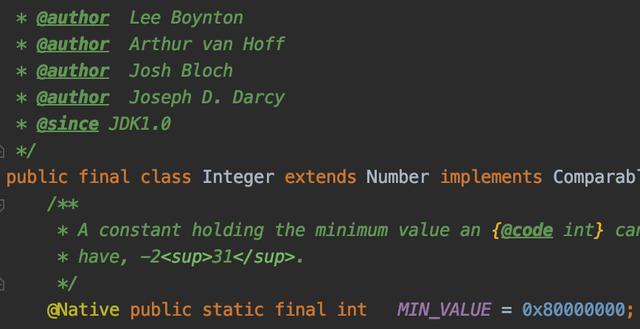
- Integer简述
Integer是JDK1.5出现的int原生类型的包装类型,在JDK9之前版本,通常是使用构造函数的方式创建对象:
Integer integer = new Integer(1); 从JDK9开始之后,通过构造方法这种方式创建Integer对象的方式被抛弃,使用Integer提供的静态方法来创建对象:
Integer integer = Integer.valueOf(1);Integer为用户创建integer对象提供了基于int和String的两种类型的方式:
下面主要讨论的基于jdk11的源码进行分析。
- Integer基本属性
//Integer可以装箱的int最小值,采用16进制表示@Native public static final int MIN_VALUE = 0x80000000;//Integer可以装箱的int最大值@Native public static final int MAX_VALUE = 0x7fffffff;//实际保存原生int的值private final int value;//表示的Integer所表示的int类型占32位@Native public static final int SIZE = 32;//表示int的字节数public static final int BYTES = SIZE / Byte.SIZE;//所有的数子和字母字符static final char[] digits = { '0' , '1' , '2' , '3' , '4' , '5' , '6' , '7' , '8' , '9' , 'a' , 'b' , 'c' , 'd' , 'e' , 'f' , 'g' , 'h' , 'i' , 'j' , 'k' , 'l' , 'm' , 'n' , 'o' , 'p' , 'q' , 'r' , 's' , 't' , 'u' , 'v' , 'w' , 'x' , 'y' , 'z' };- Integer.valueOf(int i)
下面先看源码:
@HotSpotIntrinsicCandidatepublic static Integer valueOf(int i) { if (i >= IntegerCache.low && i <= IntegerCache.high) return IntegerCache.cache[i + (-IntegerCache.low)]; return new Integer(i);}根据上面的源码,我们可以看到出现了一个IntegerCache类,该类的作用是缓存一部分int类型的自动装箱的对象值,默认情况下是缓存-128到127之间256个数字,也就是说,在jvm中无论调用几次Integer.valueOf(1),最后只会在jvm中存在一个对象。这个缓存的最大值可以在启动jvm的时候置,通过-XX:AutoBoxCacheMax=进行设置。下面具体看一下IntegerCache类的实现:
private static class IntegerCache { static final int low = -128;//定义了缓存的最小值 static final int high; //用来存储最大的缓存数值 //保存jvm创建的所有的范围在low和high之间的对象 static final Integer cache[]; static { // 默认是127 int h = 127; //如果启动JVM的时候设置了-XX:AutoBoxCacheMax参数,那么改参数值会保存到 //java.lang.Integer.IntegerCache.high此环境变量中 String integerCacheHighPropValue = VM.getSavedProperty("java.lang.Integer.IntegerCache.high"); if (integerCacheHighPropValue != null) { try { //把字符串转换为数字 int i = parseInt(integerCacheHighPropValue); //户设置的新的最大int值应该大于127 i = Math.max(i, 127); //此行的目的确保最大值小于Integer.MAX_VALUE - (-low) -1 h = Math.min(i, Integer.MAX_VALUE - (-low) -1); } catch( NumberFormatException nfe) { // If the property cannot be parsed into an int, ignore it. } } high = h; //创建保存缓存对象的数组 cache = new Integer[(high - low) + 1]; int j = low; //缓存中的对象会被全部创建出来,而不是在用到某一个再去创建某一个 for(int k = 0; k < cache.length; k++) cache[k] = new Integer(j++); assert IntegerCache.high >= 127; } private IntegerCache() {} }上面的代码中h = Math.min(i, Integer.MAX_VALUE - (-low) -1);有的人可能不理解,下面重点解释一下。IntegerCache通过它内部定义的数组来保存Integer的缓存对象。在Java中数组的最大元素个数是Integer.MAX_VALUE,由于IntegerCache还会保存128个复数和0。因此IntegerCache数组大小:
cache.size = 128+1+h(最大正数)
所以h的最大值是Integer.MAX_VALUE - (-low) -1
由上面的源码可知,当IntegerCache第一次被使用的时候,jvm就会创建所有的在缓存范围内的Integer对象。
下面的代码表示当我们需要创建的Integer对象不再缓存的范围内,才会去调用构造方法去创建新对象
if (i >= IntegerCache.low && i <= IntegerCache.high) return IntegerCache.cache[i + (-IntegerCache.low)]; return new Integer(i);至于Integer的构造方法比较简单:
@Deprecated(since="9")public Integer(int value) { this.value = value;}- valueOf(String s)
此方法的具体实现如下:
public static Integer valueOf(String s) throws NumberFormatException { return Integer.valueOf(parseInt(s, 10));}首先调用parseInt方法把传入的字符串转换为int值,然后再调用上面提到的valueOf(int i)方法。
下面介绍一下parseInt的实现原理:
public static int parseInt(String s, int radix) throws NumberFormatException{ boolean negative = false; int i = 0, len = s.length(); int limit = -Integer.MAX_VALUE; if (len > 0) { char firstChar = s.charAt(0); //判断一个字符是不是是 '-' if (firstChar < '0') { if (firstChar == '-') { negative = true; limit = Integer.MIN_VALUE; } else if (firstChar != '+') { throw NumberFormatException.forInputString(s); } if (len == 1) { throw NumberFormatException.forInputString(s); } i++; } int multmin = limit / radix; int result = 0; //避免溢出 while (i < len) { int digit = Character.digit(s.charAt(i++), radix); if (digit < 0 || result < multmin) { throw NumberFormatException.forInputString(s); } result *= radix; if (result < limit + digit) { throw NumberFormatException.forInputString(s); } result -= digit; } return negative ? result : -result; } else { throw NumberFormatException.forInputString(s); }}在parseInt方法的主要实现原理就是,从左到右获取字符串中的每个数字字符,将数字字符转换为对应的数字:
int digit = Character.digit(s.charAt(i++), radix);然后把上一轮转换的结果进行扩展(result是保存每一数字处理后的结果):
result *= radix;//一般转换的是十进制数据,因此radix=10然后把加上result的值加上本次获取digit,也就是说正常的逻辑是:
比如转换的字符为:str="3425"
1.因为str长度为4,因此需要循环4次,第一次获取第一个数字为3,本次循环结果result=3
2.第二次循环,获取到的数字为4,然后计算本次循环结果result = 3*10 +4,result = 34
3.第三次循环,获取到的数字为2,然后计算本次循环结果result = 34*10 +2,result = 342
4.第四次循环,获取到的数字为5,然后计算本次循环结果result = 342*10 +5,result = 3425
作者这里却用到了一种特殊的方式,就是使用负数的方式:
result -= digit;这样做的目的就是为了预付需要转换的数字字符串出现溢出:
//下面的代码当出现上溢或者下溢的时候执行 例如需要转换的字符串为:"-21474836490"或者"21474836490"if (result < limit + digit) { throw NumberFormatException.forInputString(s);}



















 154
154











 被折叠的 条评论
为什么被折叠?
被折叠的 条评论
为什么被折叠?








